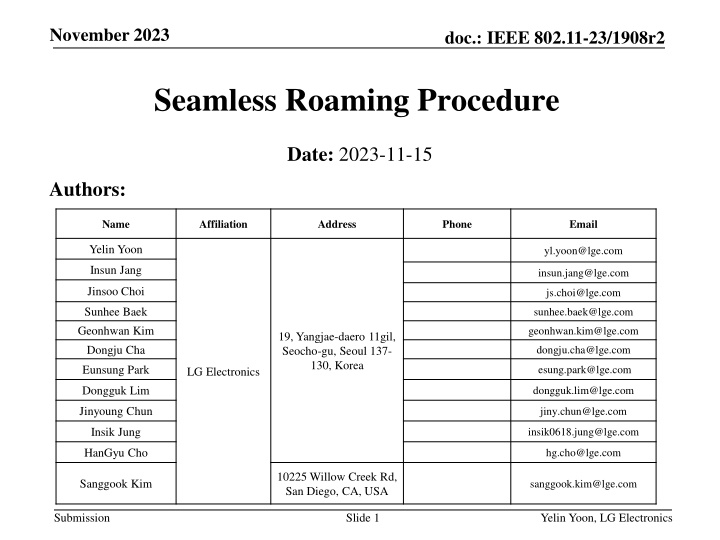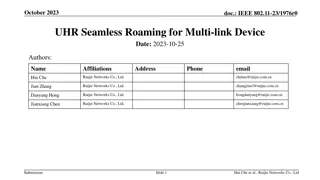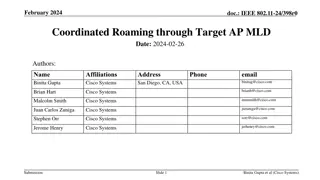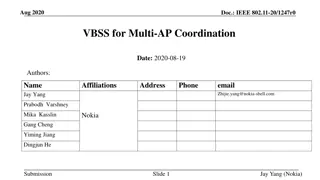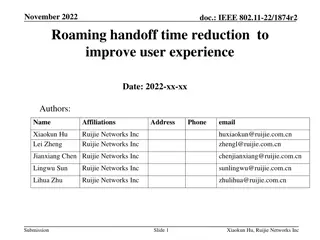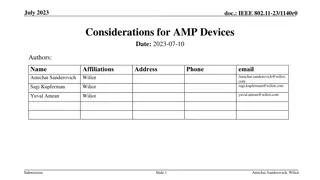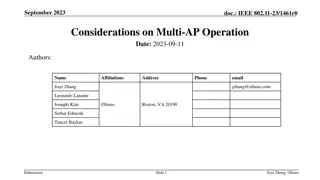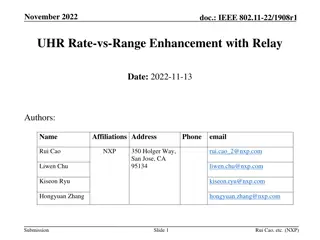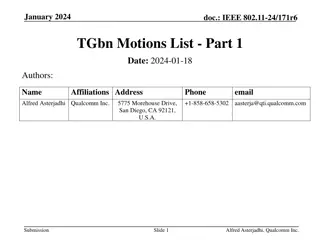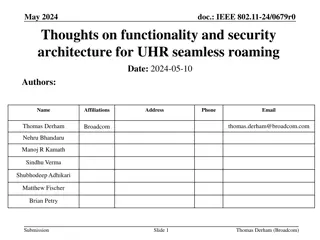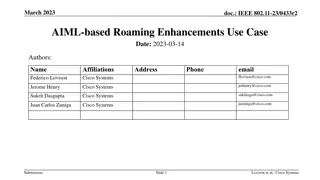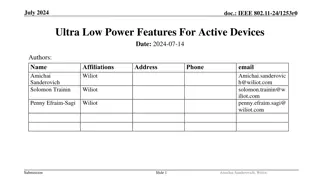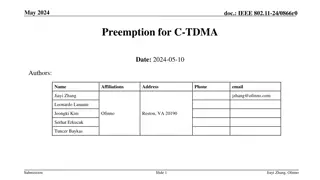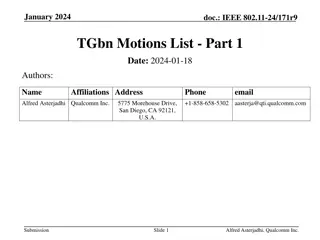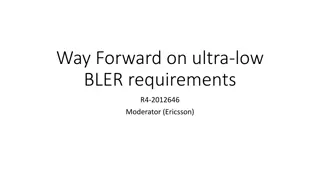Seamless Roaming Procedure for Ultra High Reliability in IEEE 802.11-23
This document outlines a seamless roaming procedure introduced by LG Electronics to enable seamless mobility in IEEE 802.11-23 networks. The procedure addresses challenges in achieving reliable connectivity and quality of experience for mobile users, focusing on data continuity and efficient frame exchanges.
Download Presentation

Please find below an Image/Link to download the presentation.
The content on the website is provided AS IS for your information and personal use only. It may not be sold, licensed, or shared on other websites without obtaining consent from the author.If you encounter any issues during the download, it is possible that the publisher has removed the file from their server.
You are allowed to download the files provided on this website for personal or commercial use, subject to the condition that they are used lawfully. All files are the property of their respective owners.
The content on the website is provided AS IS for your information and personal use only. It may not be sold, licensed, or shared on other websites without obtaining consent from the author.
E N D
Presentation Transcript
November 2023 doc.: IEEE 802.11-23/1908r2 Seamless Roaming Procedure Date: 2023-11-15 Authors: Name Affiliation Address Phone Email Yelin Yoon yl.yoon@lge.com Insun Jang insun.jang@lge.com Jinsoo Choi js.choi@lge.com Sunhee Baek Geonhwan Kim Dongju Cha sunhee.baek@lge.com geonhwan.kim@lge.com 19, Yangjae-daero 11gil, Seocho-gu, Seoul 137- 130, Korea dongju.cha@lge.com Eunsung Park esung.park@lge.com LG Electronics Dongguk Lim dongguk.lim@lge.com Jinyoung Chun jiny.chun@lge.com Insik Jung insik0618.jung@lge.com HanGyu Cho hg.cho@lge.com 10225 Willow Creek Rd, San Diego, CA, USA Sanggook Kim sanggook.kim@lge.com Submission Slide 1 Yelin Yoon, LG Electronics
November 2023 doc.: IEEE 802.11-23/1908r2 Abstract Seamless mobility, a feature outlined in UHR PAR [1], requires a mechanism that ensures reliable connectivity and quality of experience for mobile users [1] In this presentation, we introduce a seamless roaming procedure to enable seamless mobility Submission Slide 2 Yelin Yoon et. al, LG Electronics
November 2023 doc.: IEEE 802.11-23/1908r2 Re-cap In the previous meeting, we deliberated on the features that may be required for achieving seamless roaming between non-collocated APs[3]. We proposed an MLD based architecture where we have AP MLDs affiliated with the AP MLD for a seamless roaming We are going to name the AP MLD for a seamless roaming as the Ultra Fast BSS Transition (UFT) AP MLD in this contribution We want to maintain the Multi-Link setup utilizing the ML Reconfiguration We need a new method to identify the APs affiliated with the UFT AP MLD. Submission Slide 3 Yelin Yoon et. al, LG Electronics
November 2023 doc.: IEEE 802.11-23/1908r2 Motivation (1/2) Current roaming mechanisms, including Fast BSS Transition, fall short in providing seamless roaming Despite its attempts to expedite the process, re-authentication and re- association processes lead to significant time delays which is taking too much time. Additionally, the data discontinuity experienced during disassociation and re-association with the target AP further aggravates these delays Submission Slide 4 Yelin Yoon et. al, LG Electronics
November 2023 doc.: IEEE 802.11-23/1908r2 Motivation (2/2) We need a new framework to achieve Ultra High Reliability (UHR) . This framework should address the challenges posed by current methods and we can implement the following key features: Data Continuity: Ensures seamless data transfer and facilitates the exchange of data between the serving AP MLD and the target AP MLD Efficient Frame Exchanges: Minimizes the delays caused by frame exchanges during re-authentication and re-association processes Preserving the Multi-Link Setup Submission Slide 5 Yelin Yoon et. al, LG Electronics
November 2023 doc.: IEEE 802.11-23/1908r2 Roaming Procedure Before Roaming Before a non-AP MLD roams to another AP MLD, the UFT AP MLD needs to announce all its affiliated APs and some additional information, including: Seamless Roaming Support Whether the seamless roaming is supported by both AP MLD and non-AP MLD AP MLD recommendation list The non-AP MLD can ask for the recommended list of APs to the UFT AP MLD using a ML Probe Request frame. The UFT AP MLD may respond with the list using an ML Probe Response frame We can use a Reconfiguration Notify frame without any preceding requesting frame. Alternatively, the non-AP MLD can initiate by sending a request frame to solicit the Reconfiguration Notify frame. This list may also specify the order of the links based on preference or priority Submission Slide 6 Yelin Yoon et. al, LG Electronics
November 2023 doc.: IEEE 802.11-23/1908r2 Roaming Procedure During Roaming (1/3) During roaming, an AP MLD and a non-AP MLD should maintain the Multi-Link Setup using a Reconfiguration process The roaming process should be triggered first and this involves: The non-AP MLD or the UFT AP MLD selects the target AP MLD for roaming and sends a Reconfiguration Request frame Upon accepting the roaming request, the UFT AP MLD or the non-AP MLD responds with a Reconfiguration Response frame Submission Slide 7 Yelin Yoon et. al, LG Electronics
November 2023 doc.: IEEE 802.11-23/1908r2 Roaming Procedure During Roaming (2/3) While reconfiguring, we have three methods of link transition: Add then Delete: A *new link is added, and subsequently, the *old link is deleted Link Switch (Delete then add at once): The old link and the new link are deleted and added simultaneously Delete then Add: The old link is deleted first, followed by the addition of the new link With all these options, we need to ensure that at least one link must be maintained between the UFT AP MLD and the non-AP MLD Link add then delete 1. The non-AP MLD establishes a new link with the target AP MLD first 2. Once the new data path is operational, data from the DS is transferred to the target AP MLD 3. The link connected to the serving AP MLD is then deleted Requirement: This method requires a non-AP MLD to support for dual connectivity. *New link: the link between the target AP MLD and the non-AP MLD *Old link: The link between the serving AP MLD and the non-AP MLD Submission Slide 8 Yelin Yoon et. al, LG Electronics
November 2023 doc.: IEEE 802.11-23/1908r2 Roaming Procedure During Roaming (3/3) Link switch (Delete then add at once) 1. The UFT AP MLD or the non-AP MLD announces the link it intends to delete and add in a single frame 2. Once the request is sent, a timer is set for a link deletion and the data is shared via the newly added link 3. Upon the timer expiration, roaming concludes Requirement: If the new link operates on a different channel, the AP MLD may need to notify the remaining time for the channel switch. NOTE - Data continuity cannot be guaranteed in single STA operation. Link delete then add 1. The link connected to the AP affiliated with the serving AP MLD is deleted 2. Data is shared either by the remaining link or the previously added link 3. A new link is added to the target AP MLD Requirement: To maintain data continuity, at least one link must remain connected to the AP affiliated with the serving AP MLD until the new link is added NOTE - Data continuity cannot be guaranteed in single STA operation. Submission Slide 9 Yelin Yoon et. al, LG Electronics
November 2023 doc.: IEEE 802.11-23/1908r2 Roaming Procedure After Roaming After the non-AP MLD has successfully roamed to the target AP MLD, several considerations come into play: Ensure that the Multi-Link Setup is preserved with the link that is newly added, ensuring network stability and reliability Following roaming, all links need to be reset to the TID default mode, and each link should undergo TID negotiation process after Once the link is added, the non-AP MLD and the AP MLD should be able to exchange frames right away, ensuring seamless data transmission and connectivity Submission Slide 10 Yelin Yoon et. al, LG Electronics
November 2023 doc.: IEEE 802.11-23/1908r2 Conclusion In this contribution, we have outlined a roaming process utilizing the Reconfiguration. This process includes: The Transmission of a recommended AP list Roaming triggering using the Multi-Link Reconfiguration frames Three methods of link transition, ensuring efficient and seamless connectivity during roaming Submission Slide 11 Yelin Yoon et. al, LG Electronics
November 2023 doc.: IEEE 802.11-23/1908r2 Straw Poll #1 Do you support a transition mechanism of the non-AP MLD between AP MLDs that are within the same Extended Service Set (ESS) without re-authentication and re-association? Submission Slide 12 Yelin Yoon et. al, LG Electronics
November 2023 doc.: IEEE 802.11-23/1908r2 Straw Poll #1 (Edited) Do you support to define a mechanism in 11bn that enables a non-AP MLD to roam from one AP MLD to another AP MLD and the non-AP MLD remains in state 4 (see 11.3) during and after roaming to the other AP MLD? Submission Slide 13 Yelin Yoon et. al, LG Electronics
November 2023 doc.: IEEE 802.11-23/1908r2 References [1] 11-23/480r3 UHR draft proposed PAR [2] 11-23/279r0 Considerations on Seamless Roaming [3] 11-23/1090r0 Seamless Roaming Follow-up Submission Slide 14 Yelin Yoon et. al, LG Electronics
November 2023 doc.: IEEE 802.11-23/1908r2 Appendix Link Add then Delete Link Switch Submission Slide 15 Yelin Yoon et. al, LG Electronics
November 2023 doc.: IEEE 802.11-23/1908r2 Appendix Link Delete then Add Submission Slide 16 Yelin Yoon et. al, LG Electronics
